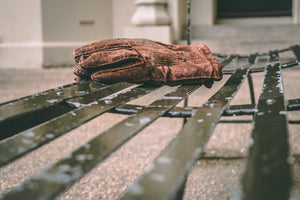Are you looking to learn how to condition leather but don't know where to start? Need a helpful guide to get you started?
Well, have no fear, for today we will be following an 8-step process to show you how it's done.
Why Condition Leather?
Before you learn how to condition leather, it might be better to learn why you might go about doing so in the first place.
- Above all else, the aesthetic quality of this exercise is important - using a leather conditioner and a soft cloth keeps your leather looking as good as possible. Leather is a form of skin taken from an animal hide and, like skin, it will age as it is exposed to the elements around it, drying out and taking on an ashen appearance. Conditioning the leather works to counter this development.
- Secondly, leather conditioners have been shown in several studies to improve the durability of a leather item, though it should be said that this is only the case for genuine leather. Leather items - like leather shoes, for example - will, as previously stated, age over time, becoming dry and brittle, thus prone to cracking even when used gently. Leather conditioning, therefore, helps to counter this aspect of a leather's aging process too.
- Leather conditioner cannot perform miracles and bring your leather back from the dead once it has cracked, but it can help to prevent it from happening in the first place, so proceed accordingly.
- In a similar way, you can also rely on leather conditioner and the natural oils within to provide a layer of protection to a leather item. As already alluded to, leather conditioner isn't some miracle cure, but it is a big part of maintaining the magic that makes a leather item so desirable. Conditioning leather can provide at least a slight layer of protection against water damage and other stains.
- If you want to fully protect your leather, though, you should also use leather protectants like leather beeswax, to protect the leather surface against foreign contaminants.

Conditioning Leather
So, now you have been converted to the bright side, let's explore the 8-step process of conditioning leather properly.
- First, remove any straps or accessories that are otherwise attached to the leather item. If you are conditioning a leather shoe, then this will perhaps include any buckles or shoelaces that you use to fasten it to your foot. If, though, you are working with a leather bag, then this will involve removing the strap or otherwise placing it out of the way for the duration of the conditioning process. This way, you can be sure that you are cleaning in as many of the nooks and crannies as possible.
- Now, using a damp cloth (a microfiber soaked in some pure lukewarm water is preferably but not entirely necessary) wipe down the entire leather surface to remove any of the surface levels of dirt, dust, and grime. Then, once you are satisfied that you have removed any surface levels of contaminants, squirt a dime-sized quantity of leather cleaner (e.g. saddle soap or Lexol leather cleaner) onto the cloth, evenly applying it to the leather and working it into the high-quality leather in circular motions. Such motions will allow the leather to better absorb the concoction.
- Now that you have applied the cleaner, allow the leather to dry overnight in a cool dry place. Here, you will want to avoid leaving the item in direct sunlight as this can have disastrous consequences for an item of leather. In fact, it can permanently change the fabric of its existence, rending it and warping it into shapes of unrepose that, once assumed, cannot be unassumed. So, it is best to leave your leather item for around 24 hours to dry in an area away from direct sunlight, lest you lose your, say, leather boots to the past from whence they came.
- Now, you can return to the leather item in question - even if it be a piece of leather furniture - and begin to work at the residue left behind, removing it in preparation for the next steps. For this, all you need is a dry cloth (preferably a microfiber cloth) that can absorb this spare product. Indeed, there is no need for shoe polish just yet. Besides the previous step, this is perhaps one of the easiest, so if you are worrying at all about it, then you are encouraged simply to think less.
- Now you are ready to get the conditioner involved, whether that be mink oil conditioner or otherwise. Before you rush ahead and dowse the whole item of leather with conditioner, you would be best advised to do a spot test to see how it takes the conditioner that you are using. * After all, if you were to use a conditioner that wasn't best suited to your own leather item, it would likely cause discoloration that would then be almost impossible to remove. * So, apply a small amount of conditioner to the surface of the leather item and leave it to sit for an hour. Conditioned leather is going to look a little darker, but if it is drastically darker or otherwise undesirable to the eye, then try using different leather cleaners and conditioners.
- Now that you have found the right conditioner for the split leather, you can apply the leather conditioner properly, squirting a dime-sized quantity onto a soft microfiber cloth. * Do avoid using homemade products that are not specifically manufactured for the job, lest you do some serious and irreversible damage to the leather item in question. * Rub the leather conditioner into the top-grain leather in circular motions with the cloth, covering the entire surface of the item so that the conditioner is as evenly distributed as possible.
- Now, as before, you can leave the leather to rest so that the conditioner is left to do its work. For this, you can use the same drying method as before, allowing the item to air-dry away from any direct sunlight. Though it is not entirely necessary to dry the item for as long as you did previously, it is still advised that you leave the conditioner to do its work overnight so that it is given the best opportunity to do its job.
- Finally, you can return to the leather item and use another dry and clean cloth to wipe away any cream polish residue that the conditioning process might have left behind. This might be especially pronounced if you have used leather honey, though it shouldn't prove too difficult to rid the surface of this residue by using a cloth.
* Now, your leather item should look smooth and hydrated and you should not be left wanting more depth from your experience. Leather goods are made from durable material and can be even more durable if kept properly.

Final Words
So, there you have it! Hopefully, you are now feeling ready and able to give conditioning your own leather items a try.
FAQs How to Condition Leather
WHAT IS THE BEST THING TO CONDITION LEATHER WITH?
While there is no one thing that is best suited to conditioning leather - there are more options than ever before for finding a conditioner that is best suited to your own leather items - there are some classic options that you can use, especially if you are more into vintage kinds of solutions. Mink oil, for example, is one such option that many would have used back in the day.
WHAT IS LEATHER CONDITIONING?
Leather conditioning is the conditioning of leather. Since leather is manufactured from the skin of an animal, it, like any skin, is prone to aging and drying as a result. Thus, just as human skin needs a little moisturizing from time to time, leather needs the same sort of care and attention in order to live a longer life.
WHAT ARE THE BENEFITS OF CONDITIONING LEATHER?
The benefits of conditioning your leather items are replete, though three interlinked benefits stick out. Conditioning your leather is not only going to ensure your leather lasts longer and is more durable, but it will also ensure that it looks even better while doing it.



